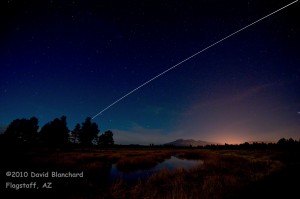As the Endeavour (STS-134) mission comes to an end NASA is one step closer to the final chapter of the Space Shuttle program. The Discovery has already flown its final mission. The upcoming flight of Atlantis will be the final and last shuttle mission.

Endeavour undocked from the International Space Station (ISS) at 8:55 pm MST 29 May 2011 (0355 UTC 30 May 2011) and began a slow separation from the ISS in preparation for its landing on Wednesday. The double flyby of the ISS and the STS-134 Endeavour over northern Arizona early this morning resulted in this spectacular image as the two spacecraft emerged from Earth’s shadow. In preparation for its return to Earth Endeavour had vented its tanks creating an ice cloud in space that was moving along with the two craft.
This is a composite of eight images of 15 seconds duration. There is a small gap between each image as the camera shutter briefly closed. Also visible in this image in the upper right is the faint track of another earth orbiting satellite — most likely COSMOS 2228 Nova 1.
Edit: Received information that the satellite is Nova1.





